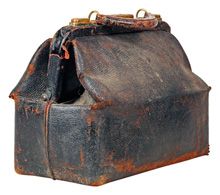Veterinarians and the media: Some observations
The folksy country doctor image is both a blessing and a curse.

Getty ImagesIf you are a television viewer, you may remember a number of years ago, in an early season of the medical drama Grey's Anatomy, the main character dating a veterinarian played by Chris O'Donnell. While Meredith Grey reported for surgical duty to a gleaming, state-of-the-art human hospital, her boyfriend toted a black leather doctor's bag filled with instruments that hearkened back to the early 1900s.
Seriously?
While I'd been working with veterinarians and animal hospitals long enough by that point to roll my eyes, I also recognized that this portrayal of the veterinary profession is common. The public is enamored with the idea of the old-school, warmhearted doc who does everything from delivering a calf out in the pasture to spaying a cat in his folksy, quaint clinic. In short-James Herriot. Or these days, Dr. Jan Pol of National Geographic's The Incredible Dr. Pol (his habits regarding pain control and sterile surgery notwithstanding).
This image works both for and against veterinarians, it seems to me. It feeds the public adoration and trust many people instinctively feel toward veterinarians, and that level of esteem in a community is never a bad thing (though some people believe that esteem is fading). On the other hand, it also feeds the assumption that veterinarians don't need to charge 21st-century-medicine prices for a corresponding level of medical care-and that they're morally and constitutionally obligated to provide that care for free if an owner can't afford to pay.
I've also heard some industry experts say that veterinarians' internalization of this folksy image holds the profession back on a fundamental level. I was speaking with one longtime veterinarian and consultant who mentioned, almost in passing, that the profession was inherently resistant to change.
I stopped him and asked for clarification. Isn't everyone resistant to change? Are veterinarians truly more unwilling to accept change than dentists, physicians, pharmacists and so on?
Yes, he replied emphatically; they are more resistant to change. And much of that resistance is tied up in this romanticized old-school view of the country vet-an entrenched self-perception along these lines keeps veterinarians as a whole looking backward to the last century rather than forward to the next, he said. Interesting thought.
The specter of the warmhearted doc imparts another effect as well: It makes media exposés such as the recent series in the Indianapolis Star (see page 28) smart all the more. How dare journalists question veterinarians' ethics and motivations? Don't they know that those doctors they're criticizing would-and often do-sacrifice money, time, sleep and family dinners to help animals and the people who love them? (The thing is, much about the stereotype-the compassion, the sacrifice, the drive-really is spot-on.)
Personally speaking, I find myself becoming indignant on the behalf of the many wonderful veterinarians I've known over the years. And therein lies the problem-to want to have it both ways. I want veterinarians to be seen as the wonderful people they are-almost above criticism and critique, if I'm being honest-and at the same time I want society to get with it and realize that Chris O'Donnell's character is just as likely to be working in a high-tech specialty hospital as Meredith Grey.
So when I read a media critique of our profession, maybe I need to take a deep breath, squelch my instinctive defensiveness on the profession's behalf, and ask whether there's any legitimacy to what has been brought to light. Are pharmaceutical manufacturers too cozy with their customers? Would veterinary medicine benefit from being held to more stringent standards regulating what drug companies can and can't do to encourage use of their product? Is it a double standard to promote “the bond” as a practice driver and insist legally that pets are just property? These are questions worth thinking about.